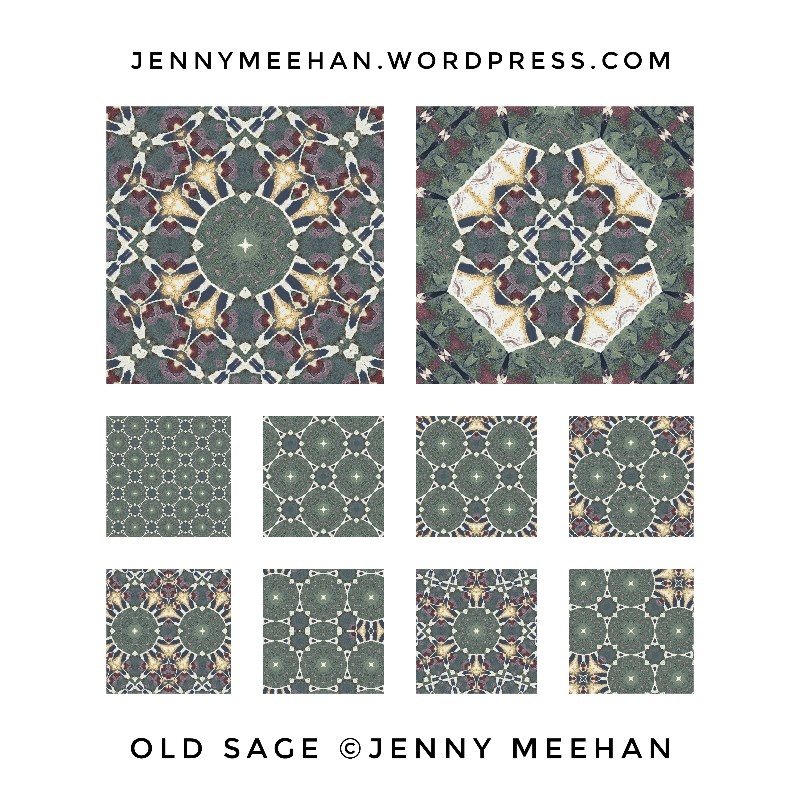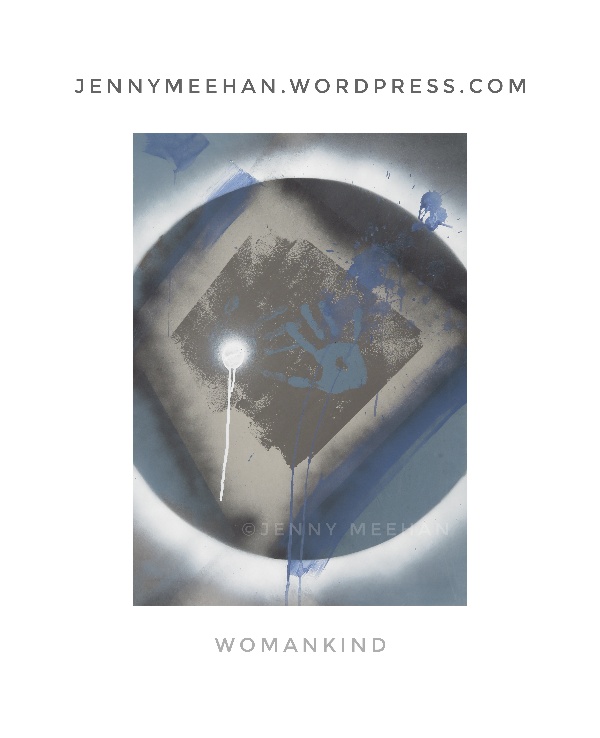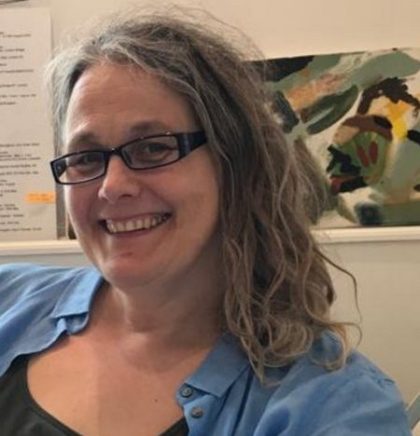February 2024!
To subscribe to this art journal, use the button above. To contact me follow link below: https://jennymeehan.wordpress.com/jenny-meehan-jennifer-meehan-how-to-contact-me/
All images, unless marked otherwise are ©jenny meehan
To start, a few paintings to view!
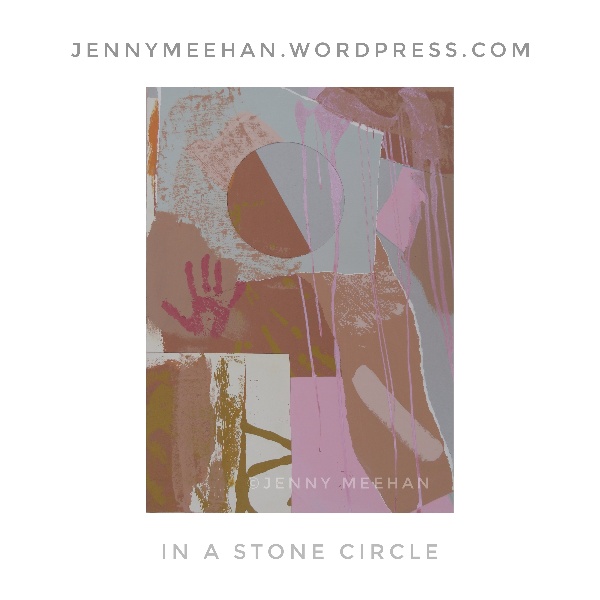
“In a Stone Circle” painting by jenny meehan ©jenny meehan
This painted collage is quite large, around A1 roughly. I now use greyboard a lot as a substrate because it’s economical and doesn’t use up too much space. I’ve gone off using oil paint and canvas. It’s for sale as an unsigned print here: https://www.redbubble.com/shop/ap/124734947?asc=u
The original painted collage is for sale Contact me using contact form if interested.
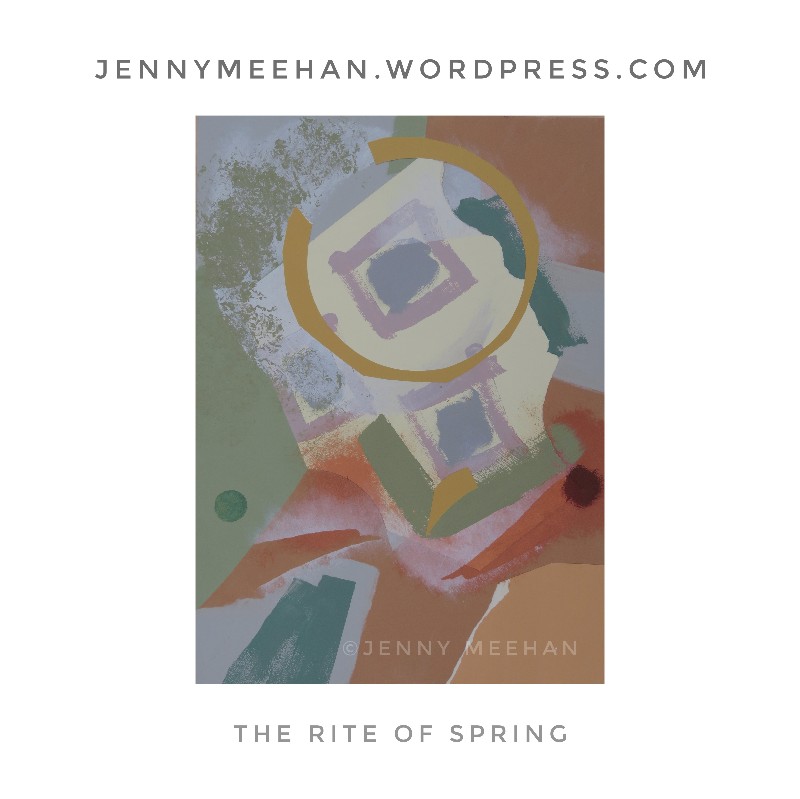
“The Rite of Spring” painting by jenny meehan ©jenny meehan
It’s the matt surface of the Keim Sol-Silicate paints along with its environmentally friendly features which has pushed me to the point of no return. Plus I use images of my painting a lot digitally and there are no unwanted reflections. It’s for sale as an unsigned print here: https://www.redbubble.com/shop/ap/124735597?asc=u
The original painted collage is for sale Contact me using contact form if interested.
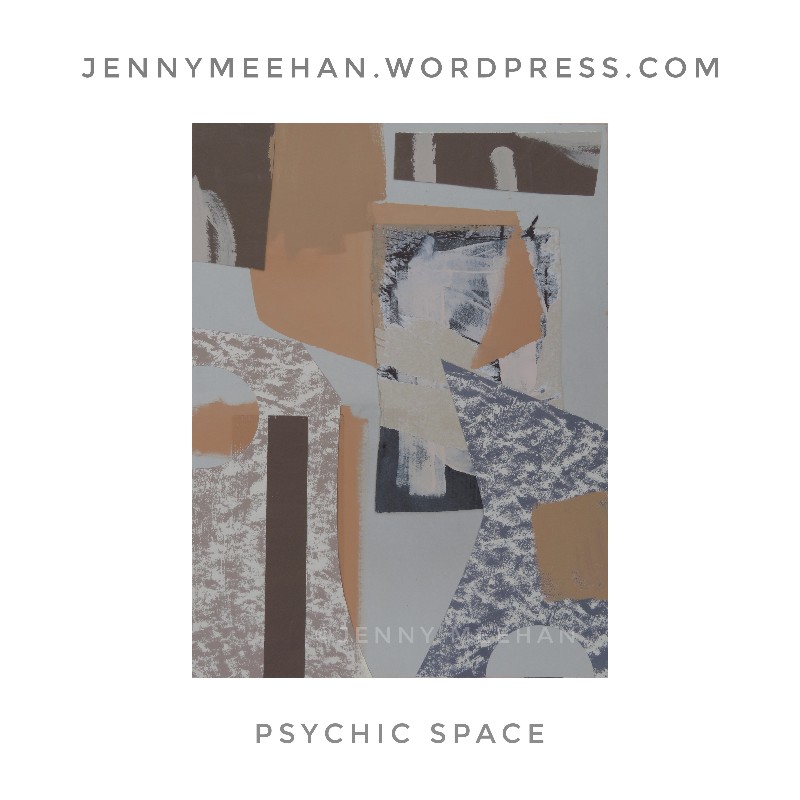
“Psychic Space” painting by jenny meehan ©jenny meehan
For me, “Psychic Space” is something I feel more aware of than I used to. The sense there is space, internal space, which is secure, liberating and in which I can experience a sense of being grounded. I guess this is to a large degree one of the benefits of having worked in tandem with a psychotherapist for so many years, along with a progressive Christian faith, prayer, meditation, contemplation and beautiful nature to help me. The images look a bit dull here, they are a lot brighter in that nice restrained way in the flesh. I’ve made a slightly brighter version for my redbubble artist profile.

“Spring Dance” painting by jenny meehan ©jenny meehan
Unfortunately the contrast between the white of a device screen and the image does it no favours! What this one does show is a strand of new developments in markmaking. I’ve become a fan of thick linear elements. It’s rather bold, I think I like the boldness. It’s a kind of liberation, not being delicate. Not that I ever have been particularly delicate.
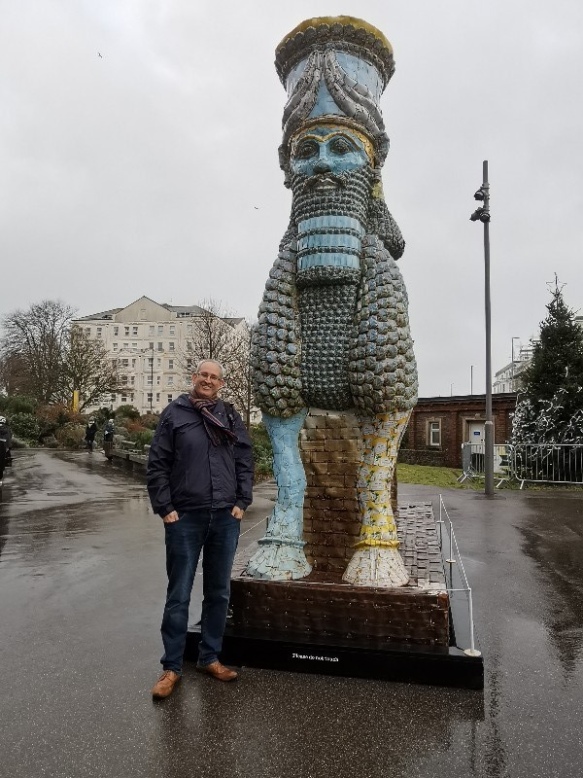 Neil Meehan my husband. We had a nice time in Eastbourne. This amazing work was a bonus. It’s by Michael Rakowitz “The invisible enemy should not exist” (Lamassu of Nineveh)
Neil Meehan my husband. We had a nice time in Eastbourne. This amazing work was a bonus. It’s by Michael Rakowitz “The invisible enemy should not exist” (Lamassu of Nineveh)
February Imbolc Meditation
Margaret Atwood Quote
“Water does not resist. Water flows. When you plunge your hand into it, all you feel is a caress. Water is not a solid wall, it will not stop you. But water always goes where it wants to go, and nothing in the end can stand against it. Water is patient. Dripping water wears away a stone. Remember that, my child. Remember you are half water. If you can’t go through an obstacle, go around it. Water does.”
Margaret Atwood, The Penelopiad
On the subject of water, I’m not Open Water Swimming this year yet, as I wait till around March before getting into the river again, though I may hop in the sea a few times before then.
Here Comes My Body
This video is a short expression of my experience of therapeutic yoga and other healing modalities such as psychoanalytic psychotherapy which have played and play a part in reconnection and recovery from dissociation, primarily due to rape trauma.
It shows a “Talkups” doll toy. The one shown is “Silly Talk”. TalkUp Dolls by Mattel were manufactured and sold in 1971. This one used the voice of JoAnne Worley.
I chose this item this because it includes both a talking voice and a body and head being pulled apart and then becoming connected again. I feel this shows very simply the tension of mind – body seperation yet also the body’s natural desire to reconnect and heal. Plus it has an element of humour, even though, in the context of its creation, this becomes rather dark.
It was not “Silly Talk” but serious talking, which brought me to a place of creating this! Talking therapies can be life savers for many people. This was the case with me.
It is also the case that I’ve been fortunate to work through a lot of childhood related distress, along with later traumatic effects resulting from two rapes and several sexual assaults. The psychological disorder which comes with these experiences can be worked through, though it is a lot of hard work. However, this process lessens the weight, and other results of early disconnections.
If you’d like to read a brief overview of the main circumstances which led me into investing myself into the personal work of psychoanalytic psychotherapy, look here: https://wp.me/prsao-1pf
It’s the part under Nigel Fountain’s Brief Encounter’s written for The Oldie Magazine.
(you will need to scroll down the post a bit)
This is relevant to “Here Comes My Body” because the the huge amount of work both myself and my therapist have needed to invest into my recovery journey in order to get to the place I am now. In an ideal world, I think every earthly judge and jury would benefit from a very comprehensive understanding and appreciation of how destructive rape actually is. Many people do valuable work in this area, but more needs to be done. As is the need in all areas of crime, of course, but crimes against humanity are more grievous than those concerning material wealth.
Anyway, back to my general direction!
What I fondly refer to “my obituary” written by Nigel Fountain for The Oldie Magazine, is something I’m very grateful for. I call it my obituary because it was a key event for me in respect to recognising, and accepting, the extent of the damage done to me, in particular, with relation the second rape, which was premeditated and involved me being drugged. The dissociation of that event was severe. I vividly recall, when I came to consciousness, looking down on my own body as I got up from the floor. Weird, I know, but sadly true. I blocked the whole thing out my consciousness mind for ten years… I couldn’t exist without denial.
When I created “Here Comes my Body” it was very much in acknowledgement of the extent of the damage done and the vast work of reconnection involved. I was drug raped 40 years ago! That’s a long time ago. It’s only now, I’m experiencing a level of connection with my physical body which resembles similar to what I had before I was raped. I say similar… I think it’s probably better actually, but I definitely have a kind of “recognition” going on, which means I feel connected to what I will call my “pre rape” body. And I’d lost that. That fundamental connection. It was stolen from me by a weak, narcissistic and totally arrogant sociopath, who was so inheritantly deceitful, that I’ve no doubt he thought his action non problematic and of little consequence. The extent to which a person’s conscience can be seared is indicative of how enslaved to evil they are.
So I tend to view Nigel Fountain’s article as a significant marker in my recovery, because my rather lengthy confessional of horrible life events, though delivered at a time when I was extremely fragile to a total stranger, turned out to be a marker in my journey of great significance. It was a point where, past and present, though completely disconnected through the fragmentation of self which comes from overwhelming trauma, meet for a moment and we realise how vulnerable us mortals are. I certainly did, and from the way he wrote about me, (which was deeply insightful), I think he did too. “Brief Encounters” was a series of articles Nigel Fountain wrote, but the one he wrote about me was published in The Oldie Magazine in June 2014.
I may be waxing lyrical a bit, I know, but I will anyway. Because to see what was “the death of me” in the sense of recognising and facing, those many circumstances and events of life which were damaging to me , and then to be able to reframe them, mainly, (though not exclusively) through therapy, and recover grounding lost, over time, is totally, a resurrected (way of) life.
I express this best in my own faith tradition and theology: the purposes of Godde in Christ are realised… This “Resurrection” and the power of divine compassionate love, are made incarnate and manifest through Godde’s grace working through and around me. This is my freedom and my deliverence from oppression of many kinds. An awareness of the Holy Spirit and a desire for the divine purposes of compassionate love.
And so, by the Thames, on that day of my “interview” with Nigel Fountain, I think I now choose to understand that fortunate meeting even as a kind of sacrament; A baptism of sorts. Why? Because the symbolism of baptism starts with death and ends with life. So having had my “obituary” written at that point is perfectly fitting for me! It was pretty similar to giving a testimony, as it happens…
In the Now
It’s wonderful to experience healthy bodily connection so deeply now, yet also shocking to see how destructive and damaging sexual violence is.
I’m grateful to our Creator for the Holy Spirit who inspires me to create. My spiritual, contemplative, and creative practices as a progressive christian inform all of my creative artworking.
New Redbubble Art Prints
Old Sage by Jenny Meehan aka jennyjimjams ©jenny meehan
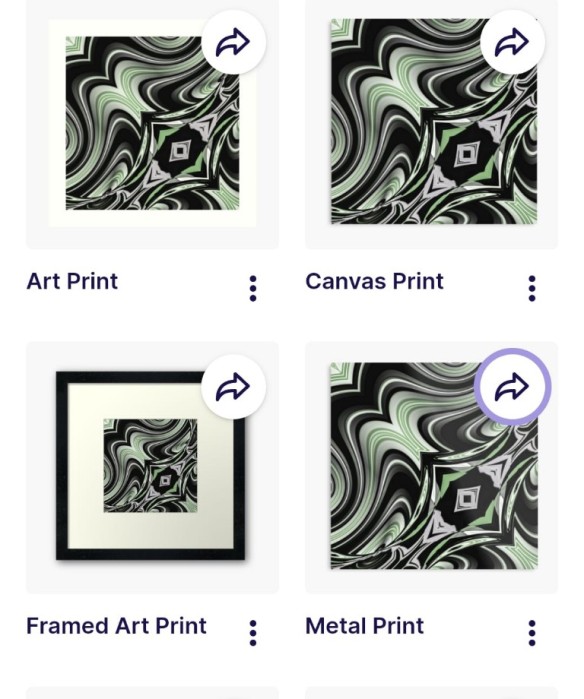
Plasticine Colour Play Abstract by Jenny Meehan
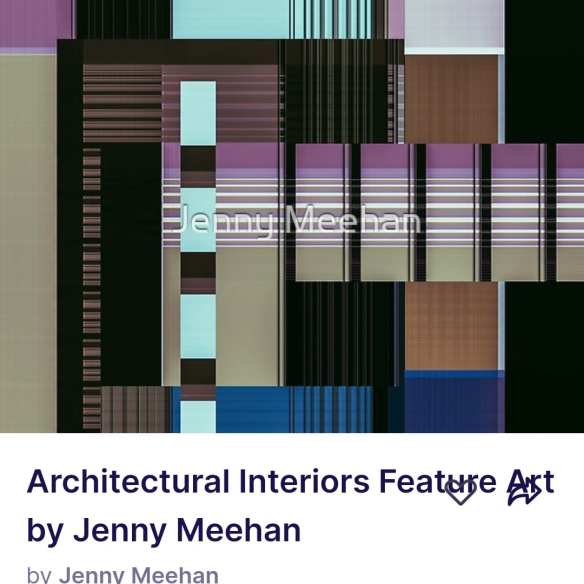
- Architectural Interiors Art Print by Jenny Meehan aka jennyjimjams
Platonic by Marisa G. Franco
I’ve just finished reading “Platonic -How Understanding Your Attachment Style Can Help You Make and Keep Friends” by Marisa G. Franco, PhD. I Love this book, and I’m so grateful that I’ve been able to read it!
It’s full of goodness… I learnt so much from it and found it touched on so many interesting areas. Here’s a snippet from it which I found linked in very well with previous my reading of “Ace: What Asexuality Reveals About Desire, Society, and the Meaning of Sex” by Angela Chen. Funnily enough, but not surprisingly, she references “Ace” by Angela Chen! Here’s a section I’ve been thinking about a lot:
“Another reason showing love for friends isn’t popular relative to doing so for romantic partners is because of the jumbling of any type of love with sexual love. We are petrified to express love for our friends, because if we do we risk accusations of being attracted to them.
But this muddling reveals our collective confusion as to different forms of love. Angela Chen reveals in her book, “Ace” what asexuality reveals about desire, society and the meaning of sex” that we feel platonic love, like appreciation and liking towards someone, romantic love; heady passion and idealisation of someone, or sexual love; a desire to have sex with someone, – separately. We can feel passionate about someone; romantic love, without wanting to have sex with them; sexual love. This means that we can feel romance in the confines of friendship. There’s even a term for it: Romantic friendship”.
Its very refreshing to read this. I have sometimes experienced the way that a degree of romantic feelings and friendship go together, and to accept this, and let this simply be as a quality and aspect of a friendship is both helpful and liberating. Our society forces categories onto us, and labels onto everything, yet in reality, life is all complexity. There’s a richness and beauty in having the freedom to experience affection (and even a touch of adoration), in our friendships.
I think that, maybe to have an understanding in our heads of the difference between attachment (bonding) and choosing to love someone in a way which is not primarily based on meeting our own needs, is helpful. I’m not suggesting needs are not important, but balancing needs in relationships is a joint endeavour, and this is the case whatever the type of relationship in question.
Another thought I’ve had on this, is that to recognise a small degree of transient infatuation, (not limerence, which is a different thing) for what it is, rather than loading it with more significance than it deserves, can be wise. To romantically objectify someone is not love, because real love is based on knowing and accepting a person for who they really are; it’s a less one dimensional experience. Fantasy is fantasy and reality is reality. The two can get blurred, but at some point they naturally become clearer.
With time, and choice, relationships often mature platonically anyway, however they start off, and can become intimate in deep multifaceted ways. There are many forms of intimacy and ways to express affection and love towards people. Platonic love is not less than Sexual love. In fact I reckon there’s some good ground to say it’s more. But this may be my age and stage in life I guess!
I’ve had several conversations recently on this topic with friends who recall to me significant female to female attractions they had in the past, which were deep bonds, established through vulnerable friendships of significant importance. Highly valuable attachments, which were cherished. For some of us this can blend in harmoniously with sexual love as well, and with others not, or less so, but whatever we conceive as our sexual identity or experience as our sexual orientation, (this itself is not set in stone) it’s the quality of the relationship itself which matters, along with the mutual integrity and level of communication.
Maybe it’s because infatuation and sexual desire often go together, we assume they are inseparable? My feeling is that the wider context of connection, mutuality, and compassionate, respectful love, is more important.
Whatever our individual perspective, the wider context is something we all need to work on, and learn to patiently become more open to each other and to become better at appreciating others differences and different perspectives, rather than become threatened or defensive about diversity.
Oh, back to the book. I’ve been carried away by my own train of thought! As I often do!
She continues ( I’ve selected sections of text);
A bit more here:
“Romantic love and friendship isn’t radical. It’s traditional, if you peek back far enough into our history. Even now, it is normal for close friends, to feel the heavy passion and idealisation that we typically deem appropriate only for spouses. Nearly all the best friends I’ve interviewed and read about have appeared to share some degree of romantic love as I’ve defined it. They are excited about and territorial of each other, idealise each other, or want to spend all their time together. When we pretend romantic love is abnormal in friendship. We leave people ashamed and confused by the deep love they feel for friends. Then, instead of expressing this love, they bury it.”
Last, but not least…
“Romantic attraction can crop up without sexual attraction. And just because we feel one doesn’t mean we feel the other. What happened? Why are we so much less comfortable now sharing this depth of love with our friends? Our discomfort with affection in friendships, coincides with the rise of homophobia, as it is expressed today. Before the 1900s sexual behaviours didn’t comprise an aspect of one’s identity, like they do today. Before 1868 There was no “Straight” or “gay” according to Hanne Blank author of “Straight: The Surprisingly Short History of Heterosexuality” because sexual orientation wasn’t an identity. People were harshly stigmatised for having sex with someone of their gender, but not for being or even seeming gay.”
In the theme of this reading I also found this excellent and interesting article by Brandon Ambrosino :
https://www.bbc.com/future/article/20170315-the-invention-of-heterosexuality
which references some of the same reading. (Brandon Ambrosino has written for the New York Times, Boston Globe, The Atlantic, Politico, Economist, and other publications. He lives in Delaware, and is a graduate student in theology at Villanova University).
Its worth adding, he’s not saying (to my understanding) that embracing a concept of a distinct sexual identity for oneself, ie, lesbian, bisexual or homosexual, etc. is a bad thing, or doesn’t have a place, nor is he saying that recognising your sexual orientation can’t be helpful, rather he’s opening up a wider recognition of fluidity in sexual identities and orientations, and opening up a discourse on the way that language and cultural changes through history can be taken into consideration when we think about differences in our sexuality. It’s important to respect that how important a defined sexual identity is to a person is going to vary a lot; this too is an area of diversity with no “right” or “wrong” approach.
Sexuality is one, very important, facet of identity but it is not a person’s identity in its totality; We are more complex than this. Historical models of sexual identity have tended to view its formation as a process undergone only by sexual minorities, while more contemporary models view the process as far more universal and attempt to present sexual identity within the larger scope of other major identity theories and processes.
My opinion is that recognising this can be helpful to many people, because identity is very complex rich and varied, with the sexual being just one aspect. Both heterosexual behavior and homosexual behavior are normal aspects of human sexuality. Lesbian, gay, and bisexual orientations, (plus the many variations we are now more aware of such as asexuality), are simply differences which we all benefit from accepting and respecting.
Well, that was an interesting stream of thought!
Winter Song by Anna Tabbush
Beautiful. I’ve been meditating on this song, and its making me cry rather a lot, but that’s all good! I have icy parts of my life and heart which need melting, and this song seems to be doing the job well!
“Winter Song”, below is a version sung by “The Wilderness Yet”
Winter Song by Anna Tabbush
When all life has left the ground
When ice like diamond sparkles around
When Jack Frost creeps under your skin
Cold winds blow out the fire within
When the swallow takes her flight
When the day is filled with night
Light a flame to guide you through
Spring will surely come to you
Darkness fills the icy gloom
Still and silent as a tomb
When the heart is heavy with woe
Fill up this room with an earthly glow
Strike a flame and touch a hand
For that is the gift of man
Light the love to guide you through
Spring will surely come to you. “
Thanks to Anna Tabbush for permission to publish the words of her poem here. Check out her work here:
Winter Song was written by Anna Tabbush, and there is another beautiful rendition of it here:
My favourite lines…
Cold winds blow out the fire within
When the day is filled with night
Light the love to guide you through
Spring will surely come to you
There is no way I can’t post up my digital image “Spring Will Come”… Its not new, one of my early ones, but the emotion behind it when it was created matches the song, so it’s reminded me of it!
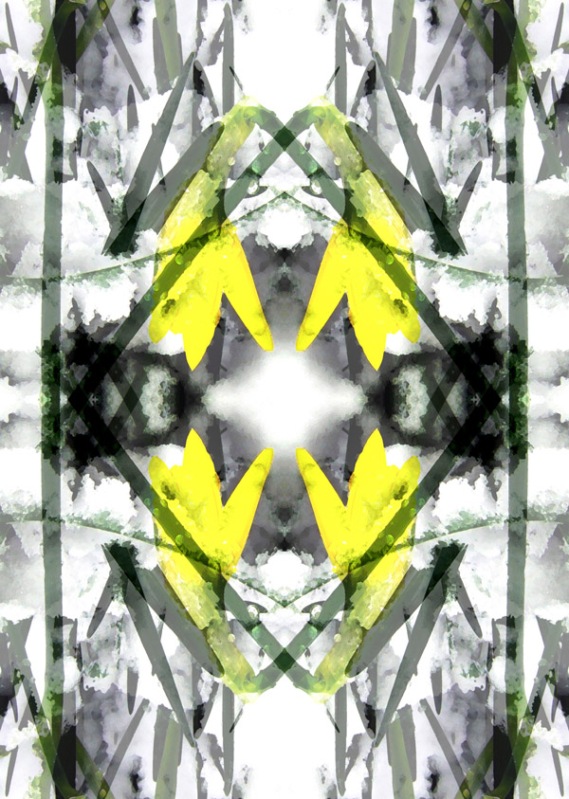
spring will come digital image jenny meehan ©jenny meehan
I created “Spring will Come” in 2008 when I was facing some hard situations, so the sight of some daffodils in the garden in the snow was an image I was motivated to experiment with digitally. Coldness, icy-ness, frozen water, glass, in my work act as a metaphor for the “freeze” state: very much an inability to move or to feel emotionally.
Ida Applebroog
![The Mother & The Weaver Marginalia (Baby with Weight), 1992 Ida Applebroog (b.1929) Oil and resin on canvas '[The subject of my work is] how power works - male over female, parents over children, governments over people, doctors over patients.' This disturbing image depicts a baby, physically bound and weighted, which makes symbolic reference to an abuse of power. Viewed from behind, the angle emphasises the child's vulnerability. The detail of the weight might suggest the presence of an emotional burden, or it could have more sinister connotations. This painting is from an extended and open-ended series called Marginalias (or 'notes in the margin'), though each painting is a stand-alone work. Applebroog embraces the new meanings that changes of contexts provide.](https://jennymeehan.files.wordpress.com/2023/11/img_20231115_151103_copy_600x800.jpg?w=584)
Came across this interesting work at the Foundling Museum! Here’s the text which was with it…
“The Mother & The Weaver Marginalia (Baby with Weight), 1992 Ida Applebroog (b.1929) Oil and resin on canvas ‘[The subject of my work is] how power works – male over female, parents over children, governments over people, doctors over patients.’
This image of a baby, physically bound and weighted makes symbolic reference to an abuse of power. The weight may suggest the presence of an emotional burden, or “it could have more sinister connotations” the text presented with it goes. I’m thinking about putting a weight on something you throw in water to make it sink… Maybe that is what they meant by that?
The painting is from an open-ended series called Marginalias (or ‘notes in the margin’), though each painting is also a stand-alone work.
Born Ida Appelbaum, Ida Applebroog was a multi-faceted artist, known for her paintings and sculptures dwelling on gender, sexual identity, and power dynamics. Her journey began with graphic design and freelancing, then developed into an exploration of societal norms.
A period of self-discovery in the late 1960s led to her iconic “bathtub sketches,” laying the foundation for her feminist-centric artistry.
Returning to New York in 1974, she embraced her new identity, Ida Applebroog, diving deeper into the societal and political discourse through her art. A series of self-published books, exhibitions, and an active part in feminist art collectives marked this period. Her work found homes in revered institutions like the Museum of Modern Art and Guggenheim Museum, solidifying her stance in the art community.
Applebroog spent the past half-century conducting a sustained enquiry into human relations. At once beguiling and disturbing, her work explores themes of violence and power, gender politics, women’s sexuality, and domestic space.
Here’s some snippets of her spoken expression;
‘I’ve been practising art for so many years, more than I can tell you right now. It’s always been the same. The point is that I always have things going on in my head. There’s a lot of note taking. Sometimes it goes wrong, but out of that comes something else, and like a snowball it just keeps gaining momentum. And time goes on until finally one piece informs the other piece, and you end up with a body of work,’
“It’s hard to say what is your work about. But for me it’s really how power works,”
“Male over female, parents over children, governments over people, doctors over patients.”
“I don’t consider myself a sculptor or a painter or a book artist or a conceptual artist. I just make art”.
“No matter what I see, no matter what I do, it all feeds me.
Anybody that creates, they’re going to find a way to create. It doesn’t matter how.”
Ida Applebroog died on October 22, 2023
The Mother & The Weaver
Here’s a quote from the Foundling Museum website:
“‘The Spider is an ode to my mother. She was my best friend. Like a spider, my mother was a weaver.’ – Louise Bourgeois, 2001
This landmark exhibition presents an opportunity to explore the Museum’s historic collection in a new light.
The Mother & The Weaver takes the unseen mother, a central part of the Foundling Museum’s story, as a point of departure to explore complex ideas around motherhood, childhood, love, loss, sexuality and identity. Occupying the whole museum, this landmark exhibition shows over 40 works from the Ursula Hauser Collection, all by women artists, in conversation with historic objects and works of art from the Foundling Museum’s collection.
The exhibition presents modern and contemporary works of art in a variety of media, including painting, textiles, sculpture, video and works on paper. The internationally celebrated artists on display include Louise Bourgeois, Marlene Dumas, Luchita Hurtado, Maria Lassnig, Sonia Gomes and Pipilotti Rist.
Maternal presence or absence, and the complex emotions that each arouses, informs many of the works in the exhibition. Others are more suggestive, hinting at complex histories of displacement and fractured identity. Themes and ideas around what it means to be a ‘good’ mother or woman, explored in the contemporary works, take on new and forceful meanings in the context of the Foundling Museum.
By presenting these works in juxtaposition with the Museum’s collection, visitors are invited to explore our stories with fresh eyes.
Ursula Hauser has been building her collection of modern and contemporary art since the 1980s. She selects artworks that captivate and move her, and places a special emphasis on female artists.
Supported by Taylor Wessing and The 1739 Club.”

Foundling Museum in London
Belly Cushion 1968 Alina Szapocznikow
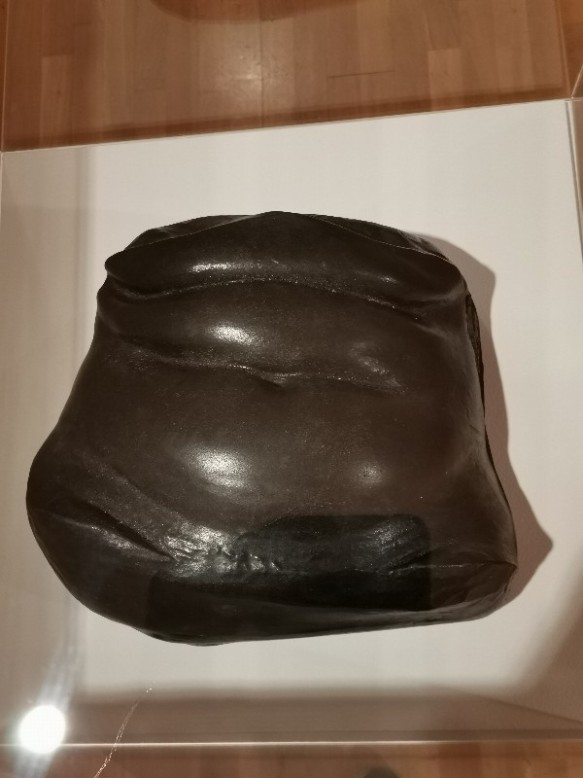
” Brzuch-poduszka / Ventre-coussi (Belly Cushion), 1968 Alina Szapocznikow (1926-1973) Mousse polyurethane
As I grapple with my own feelings about my own belly, this piece held a special place for me during my visit! The text provided was as follows:
‘I am convinced that of all the manifestations of the ephemeral, the human body is the most vulnerable, the only source of all joy, all suffering, and all truth.’
Polish artist Szapocznikow here focuses on the belly, often perceived as the source of human life through pregnancy. These cushions were based on casts the artist made of a friend’s stomach. They were intended for mass production but were never produced at scale. Szapocznikow survived the Holocaust in the concentration camps of Auschwitz and Bergen-Belsen. She rarely spoke of her traumatic experiences, instead choosing to process them through her art.”
Quoted from exhibition display
Spider V, 1999 Louise Bourgeois
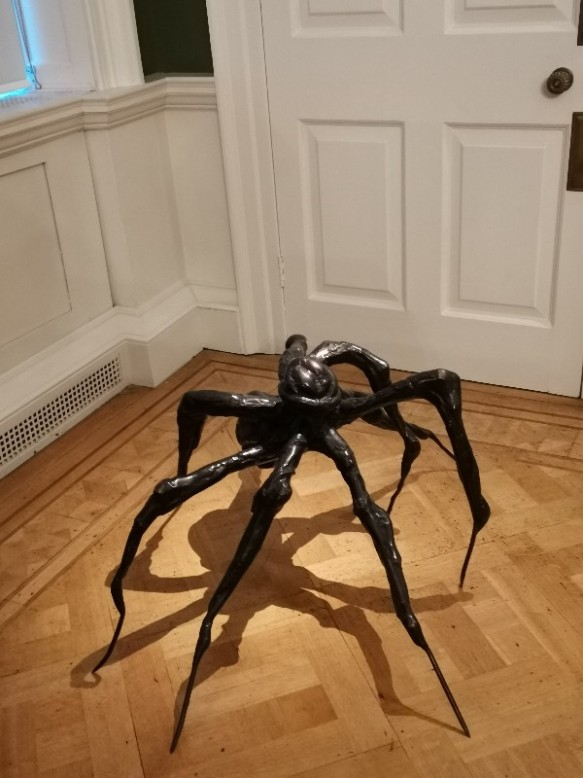
The Mother & The Weaver
“Spider V, 1999 Louise Bourgeois (1911-2010) Bronze Ed. 4/6 + 1 AP
‘I came from a family of repairers. The spider is a repairer. If you bash into the web of a spider, she doesn’t get mad. She weaves and she repairs it.’
The spider is one of the most recognisable motifs in Bourgeois’s work. These spiders refer to her own mother who was a weaver and worked in the family’s tapestry restoration business. As spiders ‘weave’ thread from their own bodies, they are also a symbol of female creativity.”
Quoted from exhibition display
I’ll post some more from this visit in later posts!
She was Fragile like a Bomb
Over the Winter months I tend to graduate towards digital media and writing, so though I’m posting a lot of my paintings this month I will also share some recent digital work with you.
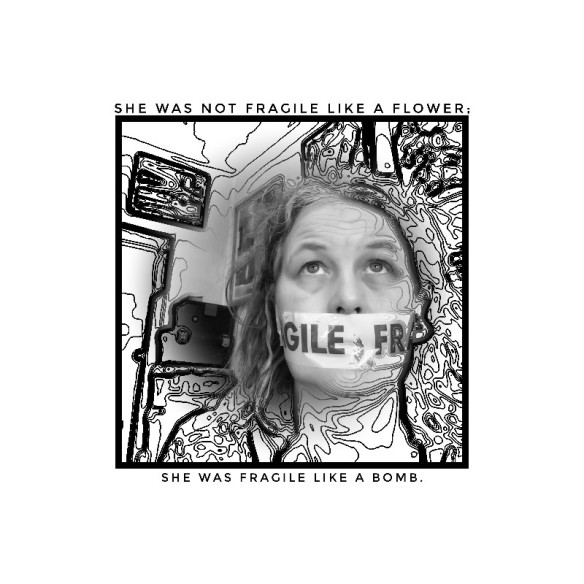
She was fragile like a bomb by Jenny Meehan
I ask myself how to embrace and channel anger into passionate action, purpose, and insight, rather than to let anger become rage, which is destructive.
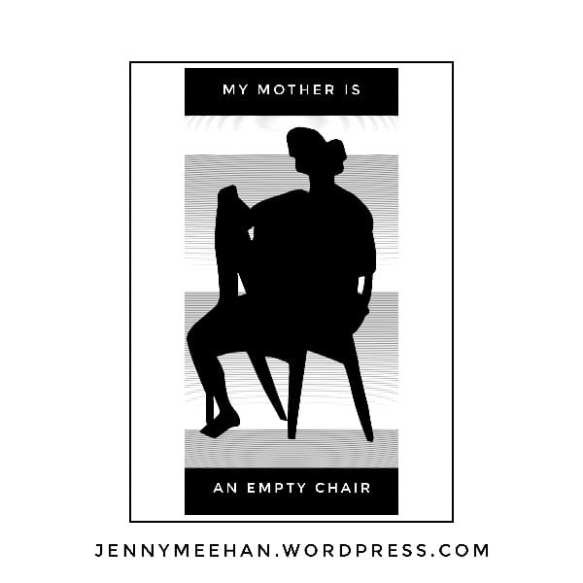
My Mother is an Empty chair ©jenny meehan
I ask myself how my mother’s absence, both psychological/emotional and physical, has impressed upon me and the way a loss presence may lessen my inner sense of stability and security.
Unravelling a Wire Nest
I created two short videos for the “16 days of activism against violence” which runs from 25th November to 10th December each year. “Unravelling a Wire Nest” is a poem I wrote over the 16 days of activism against violence period. I’ve been working on the initial draft and I’ve settled in this video poem as the end result:
The video poem I’ve titled “Love Needs No Power – Unravelling a Wire Nest”
There is also “Wire Nest without Words”
https://youtu.be/QYAo4PRyt68?feature=shared.
I think I’ll probably work into that again at some point.
In the subject of poetry, I found a poem recently and love it to bits! I’ll be taking more of a look at Sharon Owens work for sure! It’s called Dangerous Coats by Sharon Owens. I won’t quote it all because I haven’t sought permission, but here’s a fragment:
“So ladies, start sewing
Dangerous coats
Made of pockets & sedition”
Sharon Owens is a writer and painter based in Belfast, Northern Ireland. She graduated from the Belfast School of Art with a degree in Illustration in 1992 and began writing Women’s Fiction in 2002.
Here’s a link:
Below are a few random sections from some of my paintings to (nearly) finish off with!
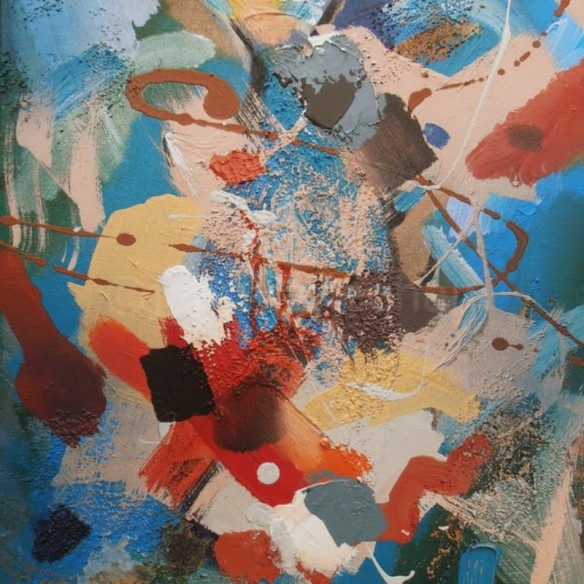
Section of Abstract painting by contemporary painter poet jenny meehan aka jennyjimjams ©jenny meehan Lyrical Abstraction London artist in art journal
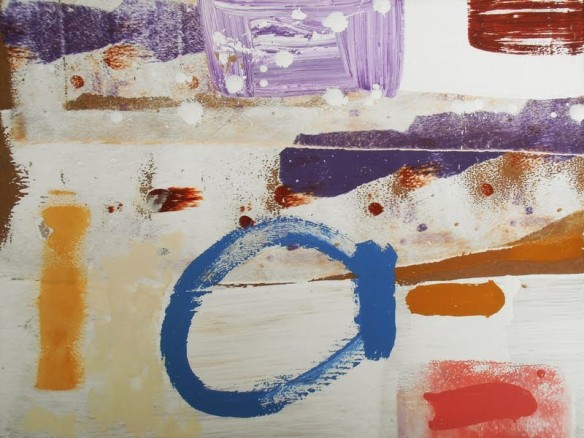
Abstract painting by contemporary painter poet jenny meehan aka jennyjimjams ©jenny meehan Lyrical Abstraction London artist in art journal
It’s been some time since I painted, but I look back on my previous paintings and it kind of feeds my mind, it’s almost like I’m going through the process of painting them again. I still feel I’m learning from them. It’s rather like looking at an experiment or exploration you made and rediscovering things all over again. I do believe contemplation is powerful.
Women Catholic Bishops
Though I am not part of the Catholic Church, it does represent a large section of the the Christian faith population, and my past participation in various retreat days and courses run by the London Jesuit Centre in London became my introduction to some aspects of Catholic perspectives and tradition. All very very good for me, as past experience was very Protestant, and, as with everything, biased in its own way.
So it was good to open myself up to some of the beautiful facets of the tradition, and a blessing indeed. It makes me sad though that there are so many women in the church held back, restricted, and limited in areas of ministry. There are moves to change this. It’s less than the best, in my view.
How lovely it is that rivers burst their banks sometimes, and women move forwards anyway, in faith, love and hope. An example is this is
The Association of Roman Catholic Women Priests (ARCWP). It is part of the world-wide Roman Catholic Women Priests movement. This traces its origin to the ordination of seven women to the priesthood by a male Roman Catholic bishop on June 29, 2002.
The ordinations took place at Passau in southeastern Germany, on the Danube River, and the “Danube 7” became the first priests of the movement. In 2003 two of the Danube 7 were ordained bishops, with a third woman from the group receiving episcopal ordination in 2005. Additional ordinations of deacons, priests, and bishops followed throughout the world.
Not surprisingly, The Roman Catholic Church has denied the validity of any ordination in the movement, and it has excommunicated women who have received ordination. This is sad, tragic, and strange, because
The Women Priests movement affirmed the validity of its ordinations, claiming that the Roman Catholic male bishop who ordained the first woman bishop was a bishop with apostolic succession within the Roman Catholic Church in communion with the pope.
I’m not really into the apostolic succession stuff, but they do have a very logical point in keeping with their tradition.
In the wake of the ordination of twelve women in Pittsburgh in 2006 there emerged a new group called Roman Catholic Women Priests (RCWP)–North America. This group divided in early 2007 into a separate Canadian organization and one called RCWP-USA. ARCWP began as the Southern Region of RCWP-USA. In 2010 members of this southern regional group, led by Bishop Brigid Mary Meehan and priests Janice Sevre-Dusynska and Judy Lee, broke away from RCWP-USA to form the Association of Roman Catholic Women Priests. Their differences of opinion with RCWP-USA over decision-making and social activism precipitated the break. ARCWP dates its origin as a separate organization within the world-wide Women Priests movement to October 21, 2010.
Since 2010 ARCWP established its own governing structure, and carried out the ordinations of many deacons, priests, and bishops who have gone on to pursue a variety of ministries. The ARCWP is an intentionally non-hierarchical organization that aspires to a consensus model of governance.
So, from a small beginning, such a lot can grow. I can see how this would be viewed as something that the more conservative in the Catholic Church would not want to grow. But grow it does, and grow it will, and where the Holy Spirit is, there is life, growth, faith, and women. Women free to move in authority, in equal authority, in Love and service.
According to its Mission Statement: “The Association of Roman Catholic women priests, therefore, responds to this call from the Holy Spirit, in our time, by preparing, ordaining and supporting qualified women and men, from all states of life, who are committed to a model of Church grounded in Jesus’ vision of an open table, where all are welcome. By our living and ministering within a community of equals, we are respectful of differences among people. In the tradition of our mystics and prophets, we challenge the dominance of patriarchal systems by promoting practices of equality that lead us to recognize and stand for justice on behalf of all people, locally and globally, and on behalf of the urgent needs of Eco-justice for our planet.”
Ah, there is hope and more. Onwards and upwards. Progress is natural. Change is vital. Life is love, and” a community of equals” is common sense, commonality, Communion in the most Christian sense.
Well, that’s me for now. Godde bless!
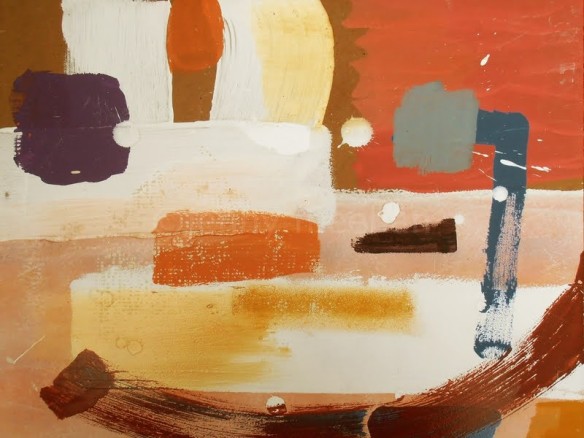
“Harbour Painting” Abstract painting by contemporary painter poet jenny meehan aka jennyjimjams ©jenny meehan Lyrical Abstraction London artist in art journal
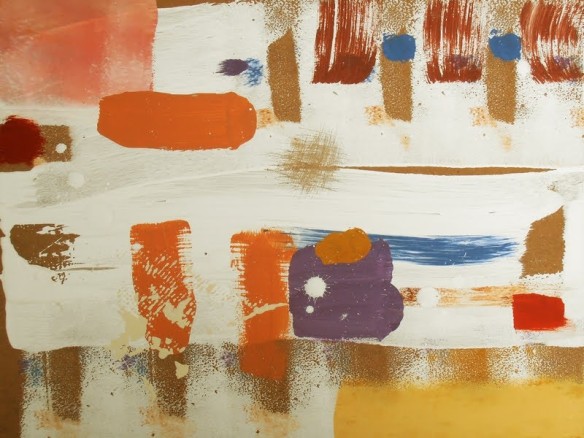
River Journey Abstract painting by contemporary painter poet jenny meehan aka jennyjimjams ©jenny meehan Lyrical Abstraction London artist in art journal
Image Licensing – Jenny Meehan
My image copyright is managed through DACS. Because they naturally propose the industry standard fees, this can be rather prohibitive for many smaller organisations and individuals seeking to use my images.
However, a big plus is…
They ensure that all paperwork and details are thoroughly and legally dealt with, including keeping their own records. All of this protects both parties ensuring a clear, error free administration.
They can also inform, advise, and generally help you as need be with the process.
Contact me directly with your image licensing request and I’ll outline the process for you.
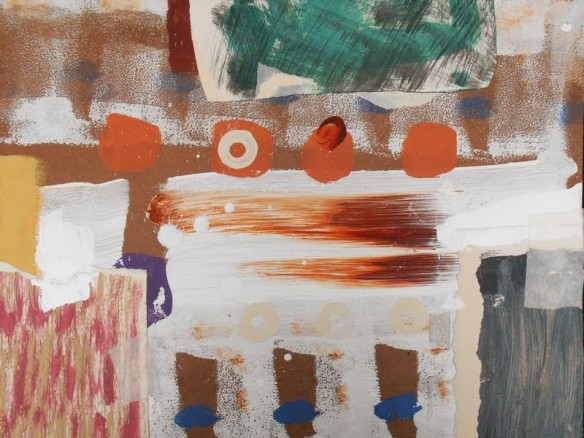
Mending Abstract painting by contemporary painter poet jenny meehan aka jennyjimjams ©jenny meehan Lyrical Abstraction London artist in art journal
Contact Jenny Meehan UK Artist Designer
I’m trying to remember to insert contact forms regularly in my blog posts! Do follow me on WordPress!
Open Water Swimming Poem Swim Wild Swim Free by Jenny Meehan
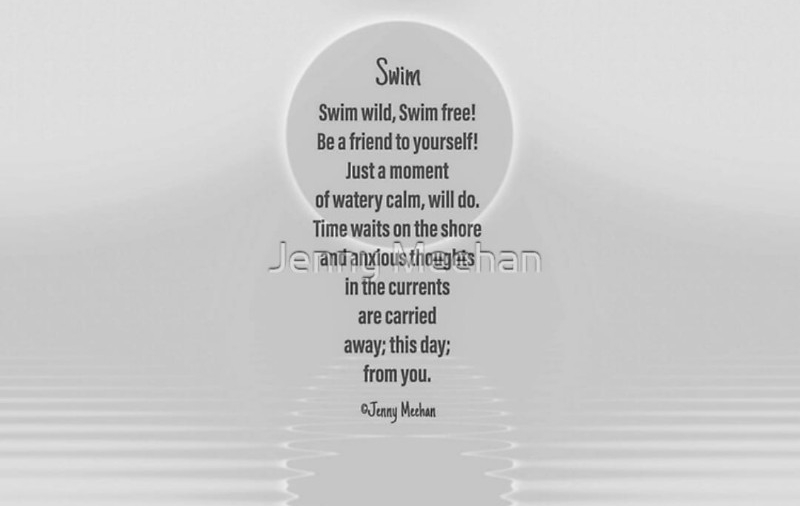
swim wild swim free poem by jenny meehan open water swimming poetry art gifts
I haven’t continued swimming in the river beyond October before, so I am surprising myself by continuing a bit further into the Autumn this year! I do wear a wetsuit jacket as I don’t like to get too cold but all the rest of me gets pretty chilly! A couple of pairs of sports leggings, socks and gloves are also handy. It gives me a real buzz and it’s such a beautiful thing to do.
I have a collection of some of my open water/wild swimming art on my jennyjimjams redbubble artist profile. This includes the poem above.
https://www.redbubble.com/people/jennyjimjams/shop
Poetry
I put my poetry with many of the art forms I use. They have a relationship. I love that relationship. Sometimes the relationship is very obvious. It’s even sometimes there when I am making a work. For example, with my pink cardboard sculpture, when I was making it I kind of knew inside it was going to be meeting up with some kind of poem or writing, even though I didn’t know exactly what it was going to be. And indeed, thankfully, on my return from West Dean College, the writing of the poem fell into it’s place too. They were a pair made for each other!
I can’t say it always works out so simply. Sometimes there is a relationship there, kind of, but it is not a fully emerged one. Sometimes the relationship takes a few years even to emerge. It is not that it wasn’t there… It is just that it was emerging, unclear, maybe only partially conscious.
Poetry
Here’s another past poem, resurrected and re edited!
I AM
When I AM,
I am here… looking carefully.
When I AM
I am here… looking wondrously, around
and within;
without anxiety.
It is better to wait.
It is better to trust.
It is better to risk
living
than to die.
Even in the darkness…
It is better to ask for help.
It is also better to feel.
Better this,
than to live in hiding.
Better this, than to be as before…
when I shut life out.
Life opens and continues to open.
Welcomes and continues to welcome.
Calls and continues to call…
I am listening.
Life has opened. It continues to open. It opens again
in an everlasting flower.
It continues to welcome
and continues to call.
Soft, silent, petals
show in a moment;
a meditation of one still second.
Tiny, but certain.
Green against the grey.
.
My poem often lacks imagery I think. I tend to use my visual work for imagery…Creating an image in a poem is a different and more refined type of art I think than my poetry, which tends more towards a narrative prose type style in the main. However, I enjoy writing it! I would like to experiment much more with my poetry writing. Now the Winter days are here I think it more likely I may succeed in investing more time in that direction!
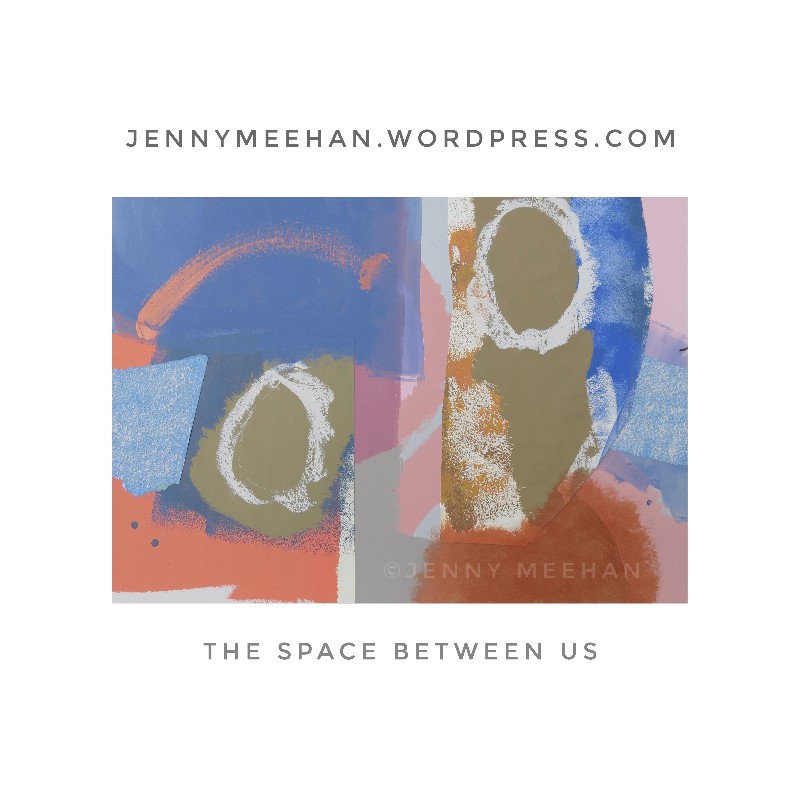
Low res image Modern art, abstract painting, jennymeehan blog, jennyjimjams artist, original artwork, London Surrey based abstract artist ©Jenny Meehan, Painter-Poet, romantic expressionist Abstraction, emotional landscape art, 21st century contemporary Art, licensable art images via DACS
The Space Between Us is one of my large (approx A1) paintings using Keim Soldalit on paper and thick cardboard. I’m really enjoying collage experiments. Space is such a practical problem for me, as our house is small and full! Now the Autumn and Winter are here, working on larger paintings has had to stop. Not that that matters too much as I play around with collage, whose piecemeal virtues and that little parts can be pulled together starting small and gradually growing outwards, as well as starting large and moving in the other direction. I also find that time spent in contemplation, reviewing the work of the Summer, and reading and writing all needs a place, and this is the season to do that! So there’s a note of humour for me as I look at this painting now… There is not enough “space between us” at the moment!
However, this wasn’t my thinking when I painted this…I was thinking about communication, sharing, and openness to others…As per Martin Buber ” Our relationships live in the space between us which is sacred.” That is the most beautiful quote ever I think. Actually…here’s more of it; ” Our relationship lives in the space between us – it doesn’t live in me or in you or even in the dialogue between the two of us – it lives in the space we live together and that space is sacred space”
Another great quote here:
“Love consists of this: two solitudes that meet, protect and greet each other” Rainer Maria Rilke
Nice.
Yoga Thoughts
Very much enjoying practising yoga again, though I would like to get into the habit of doing it a bit more than I do! It complements my Christian contemplative practice very well indeed, and is helping me recover a sense of being connected with my body which I lost. It feels to me like I am reclaiming my lost body.
I know that sounds odd, but years ago (age 5 to 13) when I used to do Ballet each week I had a relationship with my body that eroded over the years, and I ended up both disconnected, and abusing my body in various ways. I kind of rejected it and gave up on it. Working on the movements in Yoga is very helpful to me because I am becoming aware of my body and connected with it in a way that I have not been for many years.
I find the combination of breath and movement completely helpful to me…to say it is stress relieving is an understatement because it is so much more. The whole matter of being kind to my body and accepting it is also very important. I feel more agile and connected and happier with my body. Paying attention to the present is always a good thing, and I think the combination of focus, attention and breathing, for me, works very well in creating that “flow” experience which I often ramble on about!
This kind of somatic approach to recovery was suggested by my therapist a while back, but I was given a kick start to doing it because of the “ourparks.org” initiative a few years ago, which I was very grateful for. The combination of psychotherapy and the Yoga practice seem to help each other along…
It is recognised that trauma causes the body to be frozen in a state of fear. Hyper-vigilance and fear, and the whole theme of being frozen, crystallised and icy, is something which can be found in my some of my artwork. I sometimes use tiny glass beads to express a frozen state induced in my paintings. This state, experienced in extreme at the time of the traumatic event, also seems to hold itself in the body and mind, and I have experienced this many a time in therapy when we have touched certain points. It is quite strange to experience it when moving my body around when doing Yoga but very occasionally I have noticed it then.
It is my relationship with my body which is the key thing I think. I don’t really trust my body to keep me safe maybe? I sometimes feel unsafe and imagine horrible things happening to my knee (ie images of it smashing against something hard!) This is a little taste of a much wider experience and relationship with fear I have, but, as I was recognising recently in therapy, it is the relationship and the way one sees and relates to the fear (which changes over the course of recovery), not the fact that one feels the fear.
I would like to get rid of fear entirely, however, it is a fact of life, and not to be totally overwhelmed by fear, and to learn to see it from a different position, is a wonderfully liberating and joyful experience. I’m working at it through the Yoga now, as well as the therapy! I seem to be developing more feelings of being safe, and am adapting what I do in Yoga to suit my current physical state/body. What matters to me is that I can develop a nice sense of flow and grace in what I do with Yoga, and get into the breathing with body combination. This seems to be the most beneficial thing, rather than trying to torture myself with a lack of acceptance, sense of failure, and generally torturing my body. Being rather a creative person, I am finding it rather interesting to develop some of my own moves and positions too! I think my swimming, especially front crawl with the head under the water breathing technique, has pretty much the same effect too.
Incorporating body-based techniques into trauma recovery is something which makes a lot of sense for people in recovery from trauma, as trauma is so linked with the body (terror!!!!). It has been my experience that the tension and stress just holds itself within you, and you carry it around constantly. I can be chilled out and relaxed mentally, but still need to make a conscious effort to release the tension in my back and shoulders! It’s just there. My body still thinks (if bodies “think”) that it needs to be in “fight” mode, I think. The physiological effects of trauma on the body seem to lock the body in a pattern of fear.
While I had childhood experiences of physical (and emotional) violence directed towards me via my father, which did have an impact on my development, I think it was being a victim of rape in my early twenties (twice) which succeeded in helping me disconnect and dissociate from my body/mind more deeply. It actually took TEN YEARS for me to be in a place where I could even start to acknowledge what had happened to me!
The power of denial is immense… Shocking. But this is the way the body and mind cope with such things sometimes. You need to keep on living. This denial, I now understand, is not an uncommon experience for people who have been violated so. I feel so grateful to have been able to make a journey forwards in reconnection and self- compassion, and that the work of psychoanalytic psychotherapy I have been engaged with, (and continue to be engaged with), has proved so worthwhile and fruitful in so many respects.
On the body front, my video “Artifact” is an a personal explorative expression rather than a finely honed artwork….(I have very limited facilities and skills in video making!) and is probably quite a stepping stone for me in the rape recovery process. Interestingly “Artifact” can be spelt either the original British spelling way “Artefact” or the American English spelling way “Artifact”!
Here it is:
Revisiting a sense of personal desolation and loss wasn’t easy, but I think it was worth the effort. I used a sculpture I made and cast in plaster, which I titled “Venus de Milo” (related to my “Thelma” wax sculpture series) as the body…a personal relic, I suppose. In the video there is a soundtrack which includes the repeated phrase “I’m tearing myself apart”. The close examination of my body relic is painful to me, for its existence is the embodiment of a catastrophic trauma and its impact within my life. There is something about “tearing myself apart” even by my insisting on revisiting the crime of the rape and making what is almost a forensic examination maybe? Yet in the examination is the necessity to face what a crime it was.
It is a kind of crime scene I think…distressing to admit the damage done…distressing to appreciate the depth of damage and the obliteration of self. It is hard to let go…to leave that relic…yet to face it is vital…to acknowledge it is vital… but facing it is “tearing me apart” because I face the pain and reality of the crime, and in the scrutiny of it I am immersed in grief.
Yet making the video, painstaking as it was, did serve a useful purpose. Some people use relics religiously as they believe in the power of relics… the physical remains of a holy site or holy person, or objects with which they had contact somehow possess healing power. In the Christian belief, the body of the saint provided a spiritual link between life and death and between wo/man and God “because of the grace remaining in the martyr”. I think I have had this in the back of my mind, though with differences of course. I think I have maybe created and used this as some kind of resurrection tool… a way to apply the grace within me to those parts of myself which are dead? A way of re contacting myself at that point in my life, picking myself up, tenderly, and inviting the grace of my Creator deeper into my own life and body now by accepting and receiving more fully myself… all of myself…even those parts which I could not bear to acknowledge.
So in this artistic creation, I am metaphorically picking up/encountering the relic of myself and by doing so accepting what was done fully, which is painful of course. Hence the “tearing/breaking myself apart”? However, also in the process of encounter and awareness, is the grace, which I could not previously access due to the rejection of myself. This can be applied and received. There is life breathed into death.
So it’s not a negative process. Far from it, though it could be, of course, if I did not relinquish and let go of the old. Letting go is also part of the process. We can hang onto hurt, old wounding, and pain because it feels more secure. The letting go of the relic is a necessary part of the process. My poem “Bandage Box” is also part of the video.
The short video has a bit of a clunky visual motion to it…its has a rough, unprofessional feel to it, but I think it appropriate, so I found it acceptable, even maybe a bonus to the communication? There’s nothing smooth or easy about a recovery journey from rape, and the slightly stumbling and unsteady, stilted and fragmented feel to it is fitting.
I have been sexually assaulted in various ways 10 times in my life, to varying degrees ranging from drug rape to sexual harassment. I know I am far from alone in this as I know many women who have experiences like mine… too many. All violence and sexual assault has an extremely destructive effect on a person. The damage done is not appreciated or realised as much as it could be I don’t think, so maybe my experience, which is part of the creation of this video, might help in some small way. I have been fortunate to have the support and help I needed… it came late… this is true… but none the less, it came and it has been transformative.
It’s really important to recognise how much sexual assault there is. Here is some data from 2017, so not new, but still rather shocking:
Sexual Violence Statistics from Rape Crisis England and Wales.
Key statistics about rape and sexual violence in England and Wales.
In the year to the end of March 2017, the Crime Survey for England and Wales (CSEW) estimated:
20% of women and 4% of men have experienced some type of sexual assault since the age of 16, equivalent to 3.4 million female and 631,000 male victims
3.1% of women (510,000) and 0.8% of men (138,000) aged 16 to 59 had experienced a sexual assault in the last year.
In January 2013, An Overview of Sexual Offending in England and Wales, the first ever joint official statistics bulletin on sexual violence released by the Ministry of Justice (MoJ), Office for National Statistics (ONS) and Home Office, revealed:
Approximately 85,000 women and 12,000 men (aged 16 – 59) experience rape, attempted rape or sexual assault by penetration in England and Wales alone every year; that’s roughly 11 of the most serious sexual offences (of adults alone) every hour.
Only around 15% of those who experience sexual violence report to the police
Approximately 90% of those who are raped know the perpetrator prior to the offence
More key stats:
31% of young women aged 18-24 report having experienced sexual abuse in childhood (NSPCC, 2011)
Most women in the UK do not have access to a Rape Crisis Centre (Map of Gaps, 2007)
A third of people believe women who flirt are partially responsible for being raped (Amnesty, 2005)
Conviction rates for rape are far lower than other crimes, with only 5.7% of reported rape cases ending in a conviction for the perpetrator. (Kelly, Lovett and Regan, A gap or a chasm? Attrition in reported rape cases, 2005)
The information above is rather old, but does give a brief idea I think. This may be a better specific and up to date resource:
Click to access Statistics_about_sexual_violence_and_abuse_-_sources_RCEW.pdf
You can also see more up to date statistics here too: https://www.ons.gov.uk/peoplepopulationandcommunity/crimeandjustice/datasets/sexualoffencesprevalenceandvictimcharacteristicsenglandandwales
The highest ever number of rapes was recorded by police in the year ending March 2022:
70,330
In that same time period, charges
were brought in just 2,223 rape cases.
The text above is from https://rapecrisis.org.uk/get-informed/statistics-sexual-violence
I did not even realise it was this bad until I looked. Part of me wishes I hadn’t. But I guess there is the problem, because the problem is so massive and generally people tend to prefer to look away rather than acknowledge it. We are all the same in that respect… I have looked away myself… even as a victim. There’s a huge reality which needs to be faced and not avoided if society really is going to progress in a positive direction. This is what really needs to change, and it needs a lot of work, awareness, and education, plus open communication to change things.
https://www.ncbi.nlm.nih.gov/pmc/articles/PMC4491036/
I see my art working as a small contribution to the process of education and awareness. It’s small but it’s important to me that my experience is used creatively. I know it strikes a chord with people and I have had amazing feedback and responses which bring a lot of happiness to my heart.
Painting: Yoga Inhale
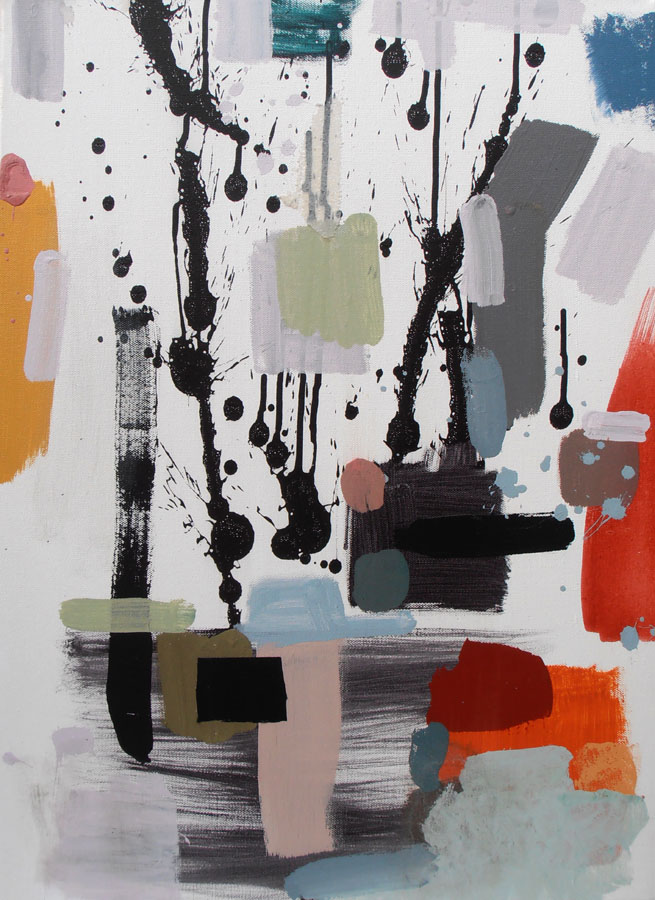
yoga Inhale British painting Lyrical Abstraction style by artist designer jenny meehan jennyjimjams colour original abstract artwork to buy and image licensing ©Jenny Meehan
Painting: Yoga Exhale
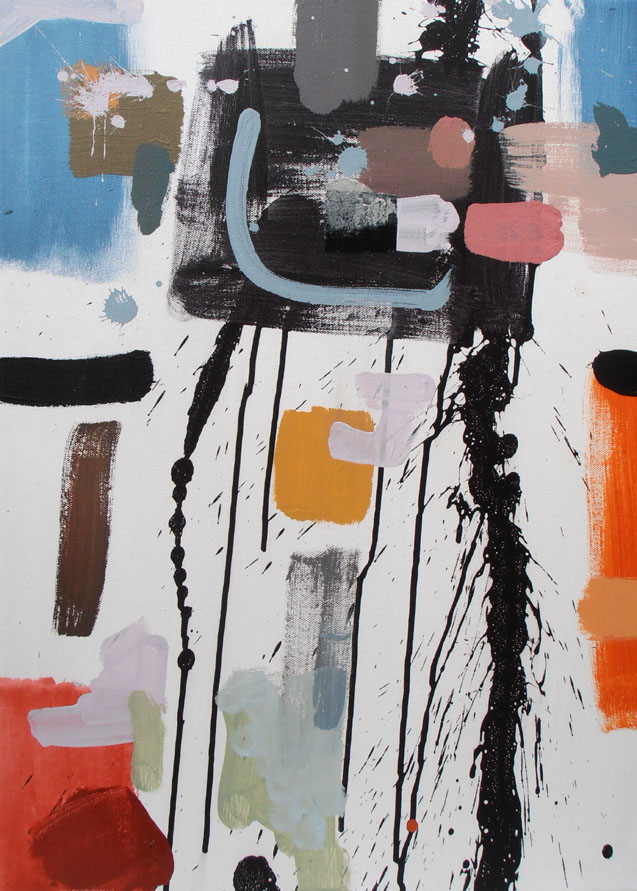
Yoga Exhale British painting Lyrical Abstraction style by artist designer jenny meehan jennyjimjams colour original abstract artwork to buy and image licensing ©Jenny Meehan
Flow Psychology
I know I have mentioned this before in my Journal, but as a quick reminder, I am very much interested in positive psychology and the ideas of psychologist Mihály Csíkszentmihályi. When immersed in something, and in a kind of mindfulness which is what you feel when you are completely focused and in a state of complete immersion in an activity, this may be described as being in a “flow”. A state of consciousness called flow is a state of concentration so focused that it amounts to absolute absorption in an activity. We might describe it as being “in the flow” of something.
This word “flow” brings me back a bit to the John Wimber days, when at the Charismatic church I was at (YEARS ago!) we all used to refer to “being in the flow” when we talked about experiencing the Holy Spirit. If one sees the Holy Spirit as, among other things, being a spirit of creativity and life energy, then our experiences of the Holy Spirit, (who is part of the Trinity in Christian thought and faith), as well as being welcomed in the experience of worshipping God in a focused way, is indeed the very same spirit that I feel when I am painting…For me, this is certainly true. I make no distinction between the spiritual refreshment I experience when immersed in my painting, or any other creative activities, to that I experience when immersed in prayer or contemplative meditation. To me, these things are one and the same. They have different dimension to them…I need to analyse and assess things when painting in a particular way…it is a type of work which is not the same as praying a prayer which is structured in the logic of words, (unless I am praying without words). But in terms of my own mind, body and spirit, they are both a place of being, of welcoming life and the Creator’s presence into my soul. Of immersion, and depth of being.
As that familiar line goes “In Him (He-She as I prefer to express!) we live and move and have our being” …in it’s context, (from Acts 17 in the New Testament… here:
“Paul then stood up in the meeting of the Areopagus and said: “People of Athens! I see that in every way you are very religious. 23For as I walked around and looked carefully at your objects of worship, I even found an altar with this inscription: TO AN UNKNOWN GOD. So you are ignorant of the very thing you worship—and this is what I am going to proclaim to you.
24“The God who made the world and everything in it is the Lord of heaven and earth and does not live in temples built by human hands. 25And he is not served by human hands, as if he needed anything. Rather, he himself gives everyone life and breath and everything else. 26From one man he made all the nations, that they should inhabit the whole earth; and he marked out their appointed times in history and the boundaries of their lands. 27God did this so that they would seek him and perhaps reach out for him and find him, though he is not far from any one of us. 28‘For in him we live and move and have our being.’b As some of your own poets have said, ‘We are his offspring.’
Anyway, back to Mihály Csíkszentmihályi…
Mihály Csíkszentmihályi describes the mental state of flow as “being completely involved in an activity for its own sake. The ego falls away. Time flies. Every action, movement, and thought follows inevitably from the previous one, like playing jazz. Your whole being is involved, and you’re using your skills to the utmost.”
It’s the ego falling away bit which is interesting me. When surrendered to the Holy Spirit while worshipping God, there is a kind of immersive experience which is both refreshing and revitalising. I also feel this when I am doing my yoga practice, as I focus on the movements and positions of my body. When I look at water, or I am swimming in water, I also find myself getting “into the flow” of feeling alive, and welcoming the Spirit into my life more.
While flow states can be task related, and related to specific objectives, and the performance related aspect is interesting, (I would like to read more about it,) I am also interested in the flow that happens purely as a result of the grace of our Creator God (ie, as the result of God’s workings, through the Holy Spirit without us “doing” anything). This also brings with it a fluidity to our thoughts and a deep feeling of peace and contentment. Our sense is of being just in the moment, ego-free, and feeling alive. I don’t know if Mihály Csíkszentmihályi considers “flow” from any spiritual perspectives at all. I found this…
“Nearly anything, it seems, can serve as a flow activity. The diversity of potentially fulfilling activities directly confronts a culture so often interested in success that can be quantified in financial and personal terms. While flow activities share several common characteristics, Csikszentmihalyi argues, finding the right activity requires a uniquely personal process of exploration and self-discovery. No matter what they are — physical exertion, study, artistic expression or spirituality — flow activities reveal themselves in the way they push the self towards complexity and growth.”
Quote from The subjectivity of happiness: on Mihaly Csikszentmihalyi’s ‘Flow’
Chase Nordengren | Jan. 5, 2012 (National Catholic Reporter)
Take a look at the whole thing:
http://ncronline.org/blogs/young-voices/subjectivity-happiness-mihaly-csikszentmihalyis-flow
I like this:
“Csikszentmihalyi is skeptical that traditional religious systems, particularly Christianity, can provide meaning to the next century’s children, trapped in existential dread. He might well be correct to assume Christian preaching is quickly consigning itself to irrelevancy on the issue of happiness. An undeveloped faith will not by itself create happiness, nor will liberation from sin. Beyond preaching on moral action, the church bears a special responsibility to project its positive view of human beings and the unique vocation given each individual person.
No matter the strength of our devotion, our repentance or our “positive thinking,” our reality will still reflect a will we cannot understand. Bad things will still happen to good people.
“The most promising faith for the future,” Csikszentmihalyi writes, “might be based on the realization that the entire universe is a system related by common laws and that it makes no sense to impose our dreams and desires on nature without taking them into account.”
Recognition of that reality — the presence of a supernatural power that has brought us into existence and our incredible powerlessness in the face of that power — is the first step on the road toward grasping for meaning in our lives. A relevant, compassionate church ought to also guide the faithful toward the second step: ensuring all work and play, rich and poor, simple and complex constitutes participation in what the U.S. bishops called “God’s creative activity.”
Wow, that’s super. Love that.
The experience of flow could be described well as blessing, I think. Someone at church recently pointed out that the Hebrew word we often translate into “blessing” very much relates to happiness:
esher: happiness, blessedness
Original Word: אַשְׁרֵי
Part of Speech: Noun Masculine
Transliteration: esher
Phonetic Spelling: (eh’-sher)
Short Definition: blessed
In my experience this happiness comes when I immersed in an activity, focused, and I view it as a gift of grace. Happiness is a gift…I think it can be received or rejected. It is a communion, a meeting with the divine as expressed in our world… It doesn’t come from things, but from relationships and love expressed. And when we are immersed in certain things, it seems we gain a sense of the divine, as we let ourselves be just in that moment. For me as a Christian, a powerfully liberating access to this blessing comes from the application in my life of a conception of the Grace of God, expressed through faith in the Lord Jesus Christ as God (one of the Trinity). In my life, Christ is welcomed as God himself, compassionate, and incarnate, (in the flesh). “God with us” in the midst of the deepest suffering, or the darkest night any soul could find itself in. A Creator God who, though powerful, is also powerless. A vulnerable Creator of the world, who understands completely the challenges of living we face, even those very extreme challenges, like extreme fear and doubt. This is a paradox we cannot understand. We cannot understand the mystery of Grace, only choose to believe it.
Yet, indeed, it is the Spirit of God within us, that brings life to our souls…whatever our beliefs, spiritual tradition, or religion. The work of the Spirit may be experienced by any heart open to God, if welcomed. God is a Creator…the source of life, and the giver of life. There is one Creator God, though understood, (in the limited way the human mind understands things!) in many different ways. When we are doing things we feel passionate about, which engage ourselves and take us beyond our own ego, and into a sacred, and holy space where we are being, just being, and taking in life in all it’s fullness…This is just a tiny taste of the heaven; a tiny taste of the experience of being immersed in the presence of God in all it’s (his/her) entirety.
I associate water with life, and life (and truth) with the Grace of God, experienced in my daily life. The whole idea of immersion (and everything to do with water!) can be linked in my own art work to the (continual) experience of Baptism, (understood as a symbolic act of conversion, ie repentance and receiving of grace) and to experiences of being immersed in the Holy Spirit..of being in a place of Flow, and of life (and new birth) which is both here and now, and also, well beyond that. A happiness and grace which is a blessing. A gift, from God. I choose to credit this kind of work to God, in his/her* good intentions and loving kindness, mercy and compassion towards ALL that is created, and understand God not as an impersonal force or “it” but a personal and relational Creator God. I credit the liberating work of continuous transformation in my life as coming from the work of Christ in me, as I choose day by day the path of being a follower of the Lord Jesus Christ. This is a key understanding that underlies my life and work, and what motivates me in my art practice to take the directions I take.
However, whatever one believes or not, whatever one’s personal angle on salvation/enlightenment, or otherwise, we all experience flow times…that feeling of being in your element. Of being in the creative zone. Of feeling truly alive! While I have rambled on passionately, there are countless times when “being in the flow” is a distant dream…When all the opposite could be expressed, just as passionately! When static, stagnant and dead, are more applicable words! But I find it helpful to consider and reflect on the relationship of my faith beliefs and the way that water has emerged as such a significant symbol in my art work, and also how my own understanding of being “in the flow” has moved from something that I used to view as being exclusively situated within those professing to be Christians, to a much wider and expansive appreciation of how blessings are experienced, and how our “Unknown God” is known to us in various ways, through our life experience. It is also the case that God, because (she-he) is God, is well beyond our comprehension, and it does us a favour to always hold this in our minds, even if we are certain of our own perspectives. We may know and comprehend many truths about God’s nature…and it is good to hold onto these things, but also good to embrace the mystery which is also God, and to appreciate the endless and eternal aspects of our Creator. As the old phrase goes “Let Go and Let God”. The two go together!
Sometimes the “letting go” bit might be more of a challenge, and slightly different from simply immersing ourselves in an enjoyable activity. Take a look at the whole article if you will, but I am thinking of this kind of thing:
“But in every case, what “Let go and let God” comes down to is this: We need to let go of our own will. We must claim as our own the incredibly hard prayer that Jesus prayed: “Father, if you are willing, take this cup from me; yet not my will, but Yours be done” (Luke 22:42). We need to let go and let God do what God wills. This submission will lead to peace and joy, even when the way is difficult. “Father, I place my life in Your hands!” (Luke 23:46).”
Quote from: Elizabeth Peale Allen https://www.guideposts.org/faith-in-daily-life/bible-resources/live-the-bible/learn-to-let-go-and-let-god.
*ps. It seems better to remind ourselves by using His/Her that God isn’t male or female…but Spirit. We think “genders” because we are human, but while God may be related to as male or female, it’s good to remind ourselves of how far beyond our definitions God is…I tend to often settle with “Father” simply because the Lord Jesus Christ did but it’s good to recognise both traditionally feminine imagery and masculine imagery when we think of God, imo! (AND to be clear that these are indeed, just images!!!! )
In the Flow Mosaic

in the flow mosaic by jenny meehan
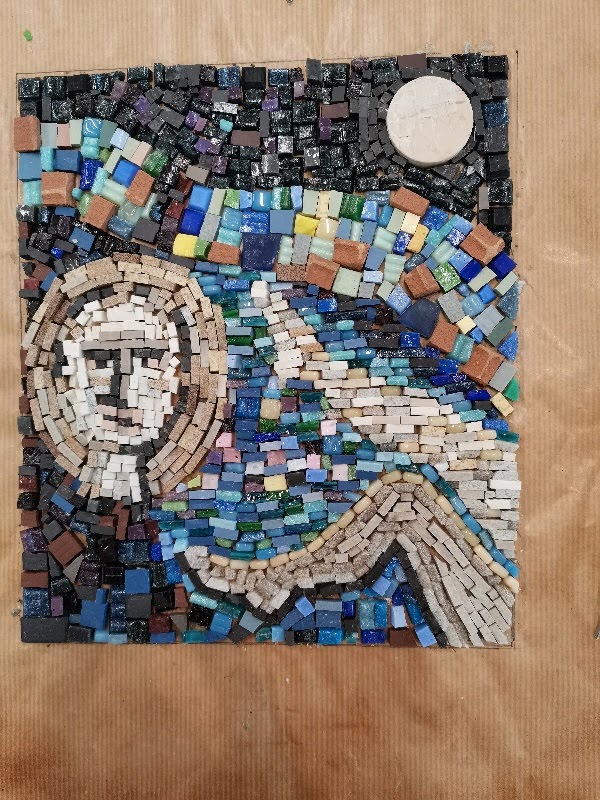
in the flow mosaic by jenny meehan
I am rather pleased about the progress of a recent mosaic…This is the reverse side, and I am excited to see what the other side will look like! It will look a bit different…I am particularly keen to see what the face looks like! There is part of a poem to go with this mosaic.
“Psyche, Body, Spirit
Unbound
She threw herself into the river
Then in an untold miracle
found
unexpected resurrection”
It’s part of a bigger poem. I do find my river swims so helpful at the moment, even though its cold! I am not exactly throwing myself into the water… rather it is a slow and gentle walk into the coldness in order to adjust to the water temperature!
Bye for now… This post is EARLY for a change. Getting stuff sorted now as December is such a busy month if I leave things till then it would be after Christmas I think until I got around to posting!

